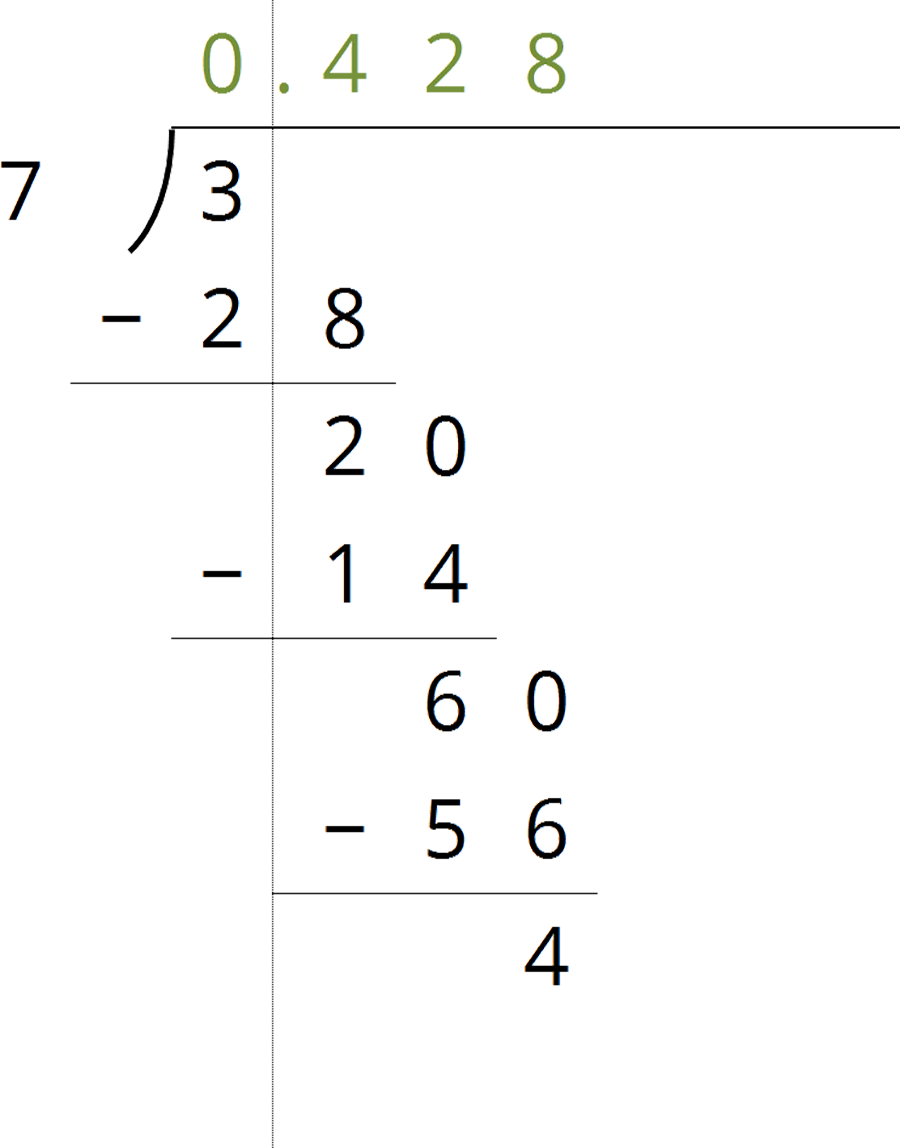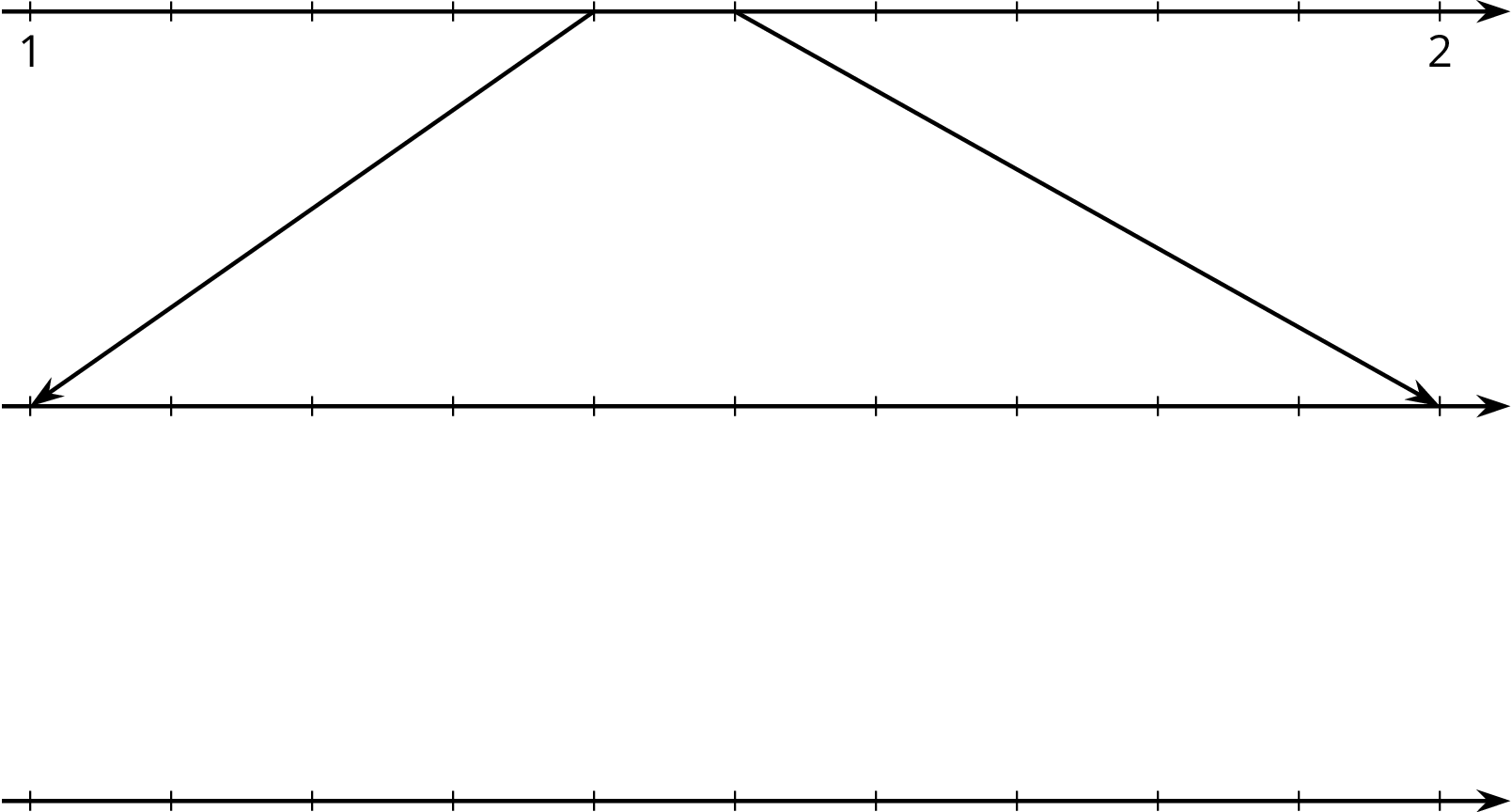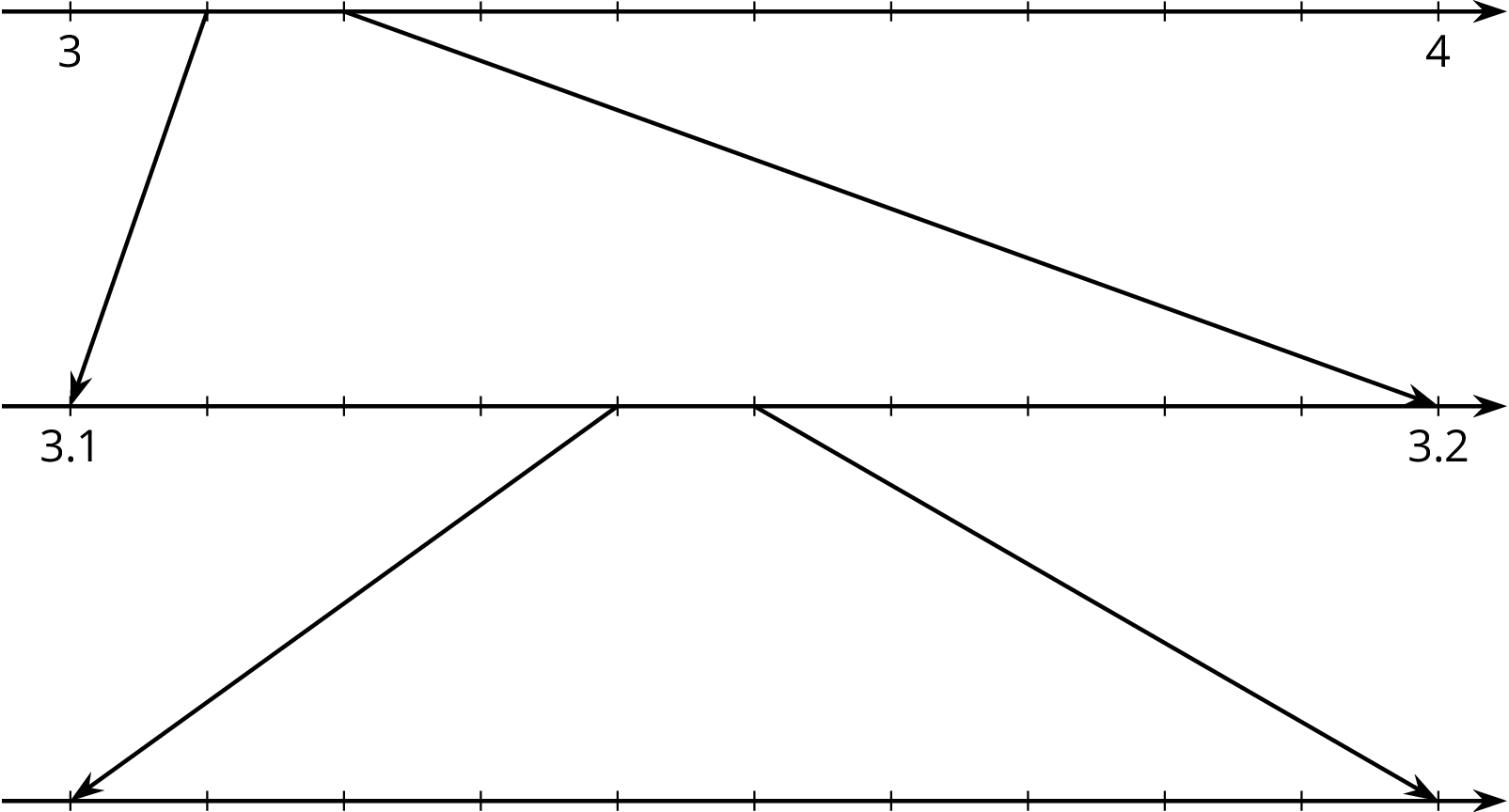Lesson 12
Infinite Decimal Expansions
12.1: Searching for Digits (5 minutes)
Warm-up
The purpose of this warm-up is to give students practice rewriting numbers in different forms. Students have re-written rational numbers with terminating decimals in fraction form and the reverse, as well as calculated the decimal form of of \(\frac{2}{11}\), which has an infinitely repeating two-digit pattern. Students are only asked to get to the first digit that repeats, which for \(\frac37\) is the 7th digit after the decimal point.
Since students are expected to notice a repeating pattern, they should not use a calculator for this activity.
Launch
Remind students of the previous activity where the decimal expansion of \(\frac{2}{11}\) was shown to be \(0.1818 . . .\) using long division and repeated reasoning.
Students in groups of 2. 1 minute of quiet work time followed by partner and whole-class discussion.
Student Facing
The first 3 digits after the decimal for the decimal expansion of \(\frac37\) have been calculated. Find the next 4 digits.

Student Response
For access, consult one of our IM Certified Partners.
Activity Synthesis
Ask students what the next 4 digits are, and record them on the calculation for all to see. Ask students, “Without calculating, what number, do you think will be next? Why?” (I think 2 will be the next digit because I can see the starting pattern has begun again.)
Continue the calculation and verify that 2 comes next. Repeat this process until reaching 4 again. Point out that this cycle will continue indefinitely, because we can completely predict what will happen at each step because it is exactly like what happened 7 steps ago.
Define a repeating decimal and show students overline notation again. State that all rational numbers have a decimal expansion that eventually repeats. Sometimes it eventually repeats 0's like \(\frac12 = 0.5000000 . . .\), and we call this terminating decimal. Be careful in the use of the word “pattern” as it can be ambiguous. For example there is a pattern to the digits of the number 0.12112111211112…, but the number is not rational.
12.2: Some Numbers Are Rational (15 minutes)
Activity
The purpose of this activity is for students to learn and practice a strategy for rewriting rational numbers with decimal representations that repeat eventually into their fraction representations. Students begin by arranging cards in order that show how the strategy was used to show \(0.4\overline{85}=\frac{481}{990}\). Next, students use the strategy to calculate the fraction representations of two other values.
The extension problem asks students to repeat the task for decimal expansions with a single repeating digit, such as \(0.\overline{3}\) and \(0.\overline{9}\). While simpler to process algebraically, it may be counter-intuitive for students to conclude that \(0.\overline{9}=1\). The fact that one number can have two different decimal expansions is often surprising, and hints at the fact that the number line has some quite subtle aspects to it. Students might insist that \(0.\overline{9}\) must be strictly less than 1, which can invite an interesting discussion as to the nature of infinite decimal expansions. If such a discussion arises, invite students to try to make their argument precise, and to try to explain where they feel there is a flaw in their argument that \(0.\overline{9}=1\). Discussion points to help resolve lingering dissonance include:
- Asking whether any numbers on the number line could be between \(0.\overline{9}\) and \(1\).
- Whether expressions like \(0.\overline{9}5\) make any sense. (They do not, since the notation \(0.\overline{9}\) notation means the pattern continues forever.)
- A second argument for those who accept that \(\frac{1}{3}=0.\overline{3}\) is to multiply both sides by 3.
Launch
Demonstrate the algorithm with an example such as converting \(0.\overline{12} = \frac{12}{99}\).
Arrange students in groups of 2. Do not provide access to calculators. Distribute a set of the slips cut out from the blackline master to each group. Tell students that once they have the cards arranged, they should work on the second problem individually and then compare their work with their partner. Finish with a whole class discussion.
Supports accessibility for: Language; Social-emotional skills
Design Principle(s): Optimize output (for generalization)
Student Facing
Your teacher will give your group a set of cards. Each card will have a calculations side and an explanation side.
-
The cards show Noah’s work calculating the fraction representation of \(0.4\overline{85}\). Arrange these in order to see how he figured out that \(0.4\overline{85} = \frac{481}{990}\) without needing a calculator.
-
Use Noah’s method to calculate the fraction representation of:
- \(0.1\overline{86}\)
- \(0.7\overline{88}\)
Student Response
For access, consult one of our IM Certified Partners.
Student Facing
Are you ready for more?
Use this technique to find fractional representations for \(0.\overline{3}\) and \(0.\overline{9}\).
Student Response
For access, consult one of our IM Certified Partners.
Activity Synthesis
The goal of this discussion is to help students build a more robust understanding of how the strategy works. Begin the discussion by selecting 2–3 students to share their work for the second problem, displaying each step for all to see. Ask if anyone completed the problem in a different way and, if so, have those students also share.
If no students notice it, point out that when rewriting \(0.7\overline{88}\), we can multiply by 100, but multiplying by 10 also works since the part that repeats is only 1 digit long.
End the discussion by asking students to rewrite \(0.3\overline{0}\) using this strategy. This is like using a sledgehammer for a nail, but it works and is reflective of the work they did in an earlier activity.
12.3: Some Numbers Are Not Rational (15 minutes)
Activity
Students first encountered irrational numbers at the start of this unit as a way to denote the side lengths of squares. They also spent time attempting to find a number of the form \(\frac{a}{b}\), where \(a\) and \(b\) are integers, that is equal to \(\sqrt{2}\) only to have it revealed that \(\sqrt{2}\) is irrational. Now that students have recently done a lot of thinking about decimal representations of rational numbers and how to convert the infinitely repeating decimal representation of a number into a fraction representation, we revisit irrationals to further the point that no such fraction representation exists for these numbers. For many irrationals, long division doesn't work as a tool to calculate a decimal approximation because there are no two integers to divide. It can be said that a square of area 2 has a side length of \(\sqrt{2}\) or that \(\sqrt{2}\) is a number that, when squared, has a value of 2 (with \(\text-\sqrt{2}\) being the other number). All this means is that different methods to approximate the value need to be discussed.
In this activity, students will approximate the value of \(\sqrt{2}\) using successive approximation and discuss how they might figure out a value for \(\pi\) using measurements of circles. Students will also plot these values on number lines accurately to the thousandth place to reinforce the idea that irrational numbers are numbers. Therefore, irrational numbers have a place on the number line even if they cannot be written as a fraction of integers.
Launch
Calculators are okay, but students should not use the root button or the \(\pi\) button. Before beginning, remind students that we have previously found decimal representations for fractions, and that knowing these representations made it easier to plot numbers on a number line. Today we are going to do the same thing with irrational numbers. Ask students “Earlier, we used long division to find decimal representations of numbers. Why can't we do that today with irrational numbers?” (Irrational numbers are ones that cannot be written as fractions.)
Follow work time with a whole-class discussion.
Supports accessibility for: Organization; Attention
Student Facing
-
- Why is \(\sqrt{2}\) between 1 and 2 on the number line?
- Why is \(\sqrt{2}\) between 1.4 and 1.5 on the number line?
- How can you figure out an approximation for \(\sqrt{2}\) accurate to 3 decimal places?
-
Label all of the tick marks. Plot \(\sqrt{2}\) on all three number lines. Make sure to add arrows from the second to the third number lines.

-
- Elena notices a beaker in science class says it has a diameter of 9 cm and measures its circumference to be 28.3 cm. What value do you get for \(\pi\) using these values and the equation for circumference, \(C=2\pi r\)?
- Diego learned that one of the space shuttle fuel tanks had a diameter of 840 cm and a circumference of 2,639 cm. What value do you get for \(\pi\) using these values and the equation for circumference, \(C=2\pi r\)?
-
Label all of the tick marks on the number lines. Use a calculator to get a very accurate approximation of \(\pi\) and plot that number on all three number lines.

- How can you explain the differences between these calculations of \(\pi\)?
Student Response
For access, consult one of our IM Certified Partners.
Activity Synthesis
The purpose of this discussion is to deepen students understanding that irrational numbers are not fractions. As such, their values are approximated using different methods than for rational numbers. Begin the discussion by asking:
- “How long do you think you could keep using the method in the first problem to find more digits of the decimal representation of \(\sqrt{2}\)?” (My calculator only shows 9 digits to the left of the decimal, so that's as far as I could go.)
- “Would this method work for any root?” (Yes, I could find the two perfect squares the square of the root is between and then start approximating the value of the root from there.)
Tell students that what they did in the first problem is a strategy called “successive approximation.” It takes time, but successive approximation works for finding more and more precise approximations of irrational numbers so long as you have a clear value to check against. In the case of \(\sqrt{2}\), since \(\sqrt{2}^2=2\), there was a clear value to test approximations against whether they are too high or too low.
Lastly, select 2–3 students to share their response to the last part of the second problem. Make sure students understand that since measuring has limitations of accuracy, any calculation of \(\pi\) using measurement, such as with the beaker and the fuel tank, will have its own accuracy limited.
Design Principle(s): Support sense-making; Maximize meta-awareness
Lesson Synthesis
Lesson Synthesis
To wrap up the lesson, emphasize that \(\sqrt{2}\) and \(\pi\) are irrational numbers. Their decimal expansions never end and never repeat like rational numbers do. But they are still numbers! The number \(\sqrt{2}\) is the length of the diagonal of a square with a side length of 1 unit. It has to be a number because you can see it when you draw a square. Similarly, \(\pi\) has to be a number because you can see it when you draw a circle. The big take away is that we have now learned about numbers that are real, but that are not fractions or their opposites. Here are some questions to discuss:
- “What are some decimals for which our method of rewriting decimals as fractions will work?” (Any repeating decimal.)
- “We’ve seen that the decimal expansion of \(\sqrt{2}\) does not repeat. What would happen if we tried to use Noah’s method on \(\sqrt{2}\)? On \(\pi\)?” (It would not work, because those numbers are irrational.)
12.4: Cool-down - Repeating in Different Ways (5 minutes)
Cool-Down
For access, consult one of our IM Certified Partners.
Student Lesson Summary
Student Facing
Not every number is rational. Earlier we tried to find a fraction whose square is equal to 2. That turns out to be impossible, although we can get pretty close (try squaring \(\frac75\)). Since there is no fraction equal to \(\sqrt{2}\) it is not a rational number, which is why we call it an irrational number. Another well-known irrational number is \(\pi\).
Any number, rational or irrational, has a decimal expansion. Sometimes it goes on forever. For example, the rational number \(\frac{2}{11}\) has the decimal expansion \(0.181818 . . . \) with the 18s repeating forever. Every rational number has a decimal expansion that either stops at some point or ends up in a repeating pattern like \(\frac2{11}\). Irrational numbers also have infinite decimal expansions, but they don't end up in a repeating pattern. From the decimal point of view we can see that rational numbers are pretty special. Most numbers are irrational, even though the numbers we use on a daily basis are more frequently rational.